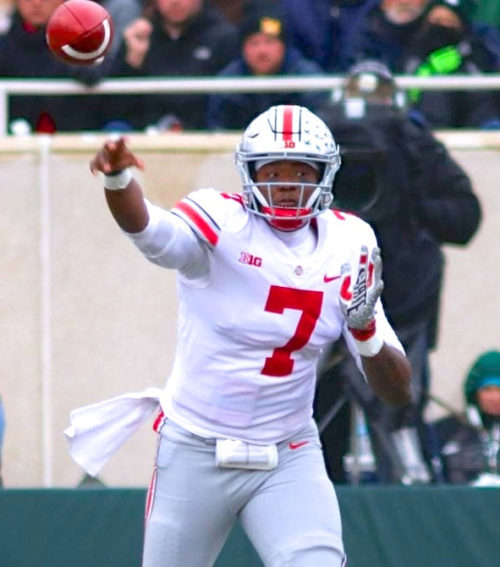Haskins was brilliant again as Buckeyes win back-to-back conference titles … Committee probably will go with Georgia or Oklahoma for last spot … Playoffs need to expand to eight teams so no legitimate title contenders get left out.
 Indianapolis – The College Football Playoff committee gathered together this weekend to watch sixth-ranked Ohio State in the Big Ten championship along with games involving other contenders, trying to identify the four teams worthy to play for the national title.
Indianapolis – The College Football Playoff committee gathered together this weekend to watch sixth-ranked Ohio State in the Big Ten championship along with games involving other contenders, trying to identify the four teams worthy to play for the national title.
But by the time the Buckeyes were midway through third quarters, the group probably had seen enough to rule them out and consider changing the channel.
Despite a sizable talent advantage and playing with the country’s best quarterback, they fiddled around so much that they were in real danger of losing and needed a late push to pull away for a 45-24 win Saturday night.
Desperate for style points to impress the committee — and starting the night behind their higher ranked peers — they were like a figure skater who tried to pull off a triple-axel for the gold medal but failed to stick the landing.
They built a 24-7 halftime lead and then reverted to the form that has plagued them much of the season, playing zombie-like defense to start the third quarter and allowing the No. 21 Wildcats to score two TDs in the first 6:57 to make it a three-point game.
But the wondrous Dwayne Haskins had easy pickings in the passing game all night and was only stopped when the coaches, in an unnecessary pursuit of balance, leaned on the running game. With victory in doubt, they turned the third-year sophomore loose.
On the last four possessions, aside from an end-of-game kneel-down, he hit Chris Olave for a 29-yard touchdown, Johnnie Dixon for a nine-yard score and J.K. Dobbins for a 17-yard TD. The only time he didn’t produce points was when Blake Haubeil had a 27-yard field goal blocked.

Dwayne
Haskins finished 34-of-41 for 499 yards and five touchdowns, with one interception, in leading Ohio State to a 12-1 record, its second consecutive Big Ten crown and a likely berth in the Rose Bowl. Though he probably won’t win the Heisman, he’s no doubt deserving of a trip to New York as a finalist.
With everything at stake in the last three games, he threw for a combined 1,383 yards and 17 TDs with just two picks.
Given all they’ve been through — the turmoil with the coaching staff and the season-ending injury to college football’s best player in Nick Bosa — beating Michigan and winning their third Big Ten title in Urban Meyer’s seven years is a laudable achievement.
But the playoffs, of course, dwarf everything. And while it might be overstating it to say they won’t be discussed at all by the committee, they probably needed more than a three-touchdown win over the Wildcats — even though they’d won 15 of their last 16 Big Ten games — to overtake the others vying for the playoffs.
Their offensive line is just a little too leaky, even though they helped Dobbins become the first Ohio State running back to rush for 1,000 yards as a freshman and sophomore. The team is too penalty-prone, getting flagged nine times for 90 yards after racking up 150 yards in infractions against Michigan. And the defense just isn’t quite championship caliber.
Although sophomore defensive end Chase Young was a beast, the Buckeyes’ confounding inconsistencies surfaced again. They gave up 77-yard TD run on the second series, but just 83 yards on the other 25 plays in the first half.
Looking like they’d post another Michigan-type performance, they let Northwestern score in five plays to start the second half.
The defense went into the game ranked 67th nationally, giving up 398.8 yards per game, and hasn’t measured up to its recent units.
In 2017, the Buckeyes were ninth overall and gave up 300.9 yards. From 2016 to ’14, they were sixth, ninth and 19th, allowing 296.8, 311.3 and 342.4 yards.
In 2013, they had plummeted to 46th nationally and surrendered 377.4 yards. Meyer made some coaching changes after that, bringing in Chris Ash as defensive coordinator. And he might have to make some hard decisions about personnel again.
Not making the playoffs would be a shame, though, because, trust me, no one in the four-team field would want to face Haskins. You can’t game-plan for arm talent like that in college.
So who gets in? I hope it’s Georgia, not Oklahoma, for the last spot. I’m rooting for the pick that would generate the most disgust and outrage, and awarding the 11-2 Bulldogs would certainly be an unpopular choice outside of the SEC. I want change.
If the CFP committee leaves out three of the five conference winners — and it would in that scenario since Alabama, Clemson and Notre Dame are locks — we’d be closer to the optimum eight-team playoff. It’d be simple to do. Eliminate the conference title games and start the playoff quarterfinals at campus sites of the top-four seeds.
That’s five conference champions and three at-large spots, with one going to the best Group of Five team (Central Florida this year).
I’m sure the PAC-12, which drew 35,134 for its league title game Friday with Washington and Utah, wouldn’t object.
The problem with four, and the problem we’ll always have with four, is that all the teams that can win it aren’t in it.
Ohio State with J.T. Barrett last season? No. Ohio State this year with Haskins? Absolutely.

Veteran columnist Doug Harris writes Buckeyes football for Press Pros Magazine.
The same could be said for whoever is left out between Georgia and Oklahoma. Maybe Michigan, too.
It’s different with the NCAA basketball tourney, where there’s no need for expansion past the current 68 teams (64 was just fine before the last bump, by the way). Everybody who can win it is already in it.
As I write this, ESPN analysts are making their projections for the top four. Georgia is getting the most nods, but Ohio State was named on at least one projection.
Which means there’s a chance.
Haskins was asked in his post-game interview what he had to say to the playoff decision-makers. He praised his teammates and then added, “If we get in, I’d put on a show.”
Yep, we’re all pretty confident of that.


